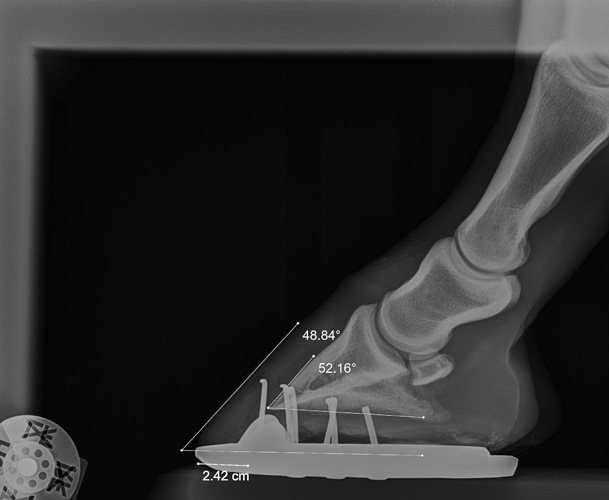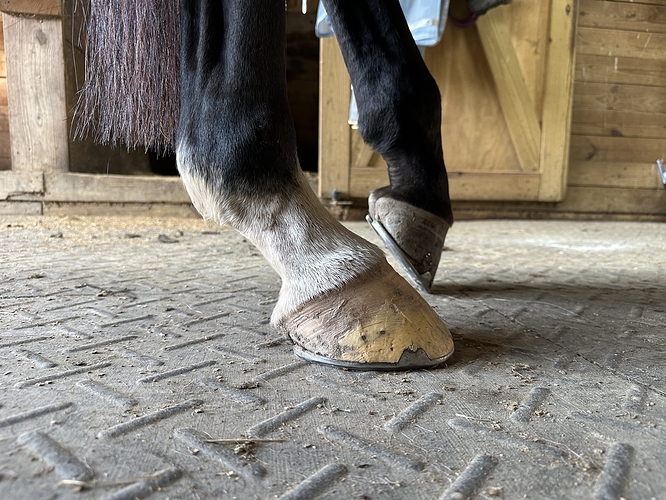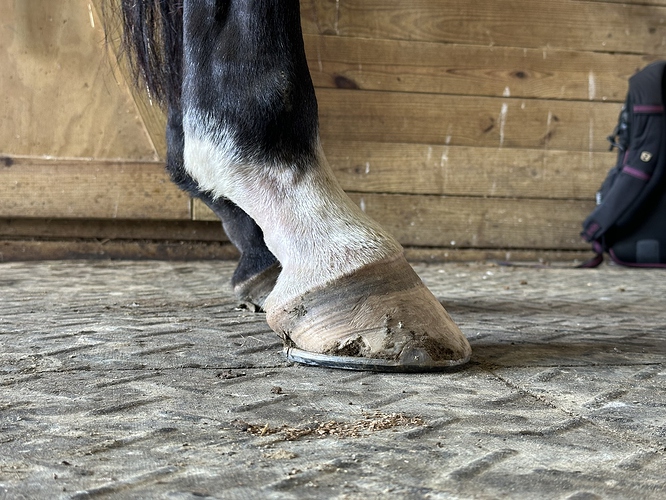Ohhh boy, where do I begin… this is a five-year saga, so buckle up, lol.
I bought my horse off the track when he was just shy of properly turning three. We didn’t do much to start with because a) he was a baby and b) he ripped off three of his four racing plates in his first two weeks with me. I decided to try keeping him barefoot behind just as an experiment. He also had some on-and-off stifle catching issues which I attributed to weakness and him growing because they would come and go. I don’t think I tried to canter him for multiple months after I started riding him, and when I did, he couldn’t hold his lead in the back. I chalked it up to weakness and gangly horse in a tiny indoor.
My trainer came out to give us a lesson that fall and, after watching him go, suggested that he should probably have hind shoes put back on because he didn’t seem to really want to step through from the back and was probably a bit sore. I was already thinking the same thing because he wasn’t growing enough foot to keep up with the wear (we genuinely had no heel left), so the shoes went back on. Over the next year, we continued the same cycle of questionable stifle, lead problems, etc., and every time I would assume he was growing again and back off until he seemed like he was “normal.”
When he was five I started asking him for more effort, and we mostly sorted out the right lead, but we were still having issues with the left. It seemed like it was probably still a weakness and balance thing because he would hold it when I cantered him out in the field, but the indoor was too much for him. He would also hold it if I rode him bareback so I assumed it was also just me being lopsided and accidentally cueing him to swap. He had a bit of a habit of bucking on the back side of fences too, but it wasn’t consistent at all and seemed like it was entirely attributable to him being excited.
The summer after he turned six (two years ago) I hauled over to my trainer’s for a jump lesson prior to a show and, after having to throw in a short stride to a tiny cross-rail, he proceed to put his head between his legs and buck for all he was worth. I came off and my trainer got on him for a few minutes so I could catch my breath. After she got off she asked me if she could try something and I said yes. When she palpated his SI area, he dropped his entire back.
(My trainer had seen him four times in three years so she was not to blame for any of the issues, I’m sure she would have spotted it much sooner had I been based at her barn at the time.)
I had the vet out the following week, they did a lameness exam, concluded it was SI because he wasn’t showing any stifle issues, and we ended up injecting him. It seemed to help a bit but it didn’t entirely resolve things with his lead swapping.
I moved him to my trainer’s barn a few months later and her vet (performance vet who comes from out of state) took a look at him. We all agreed he was too weak to really judge anything, so we decided to give it a few months of lessons to see what would happen to him with proper work. Fast forward a few months, the canter had gotten way better and then suddenly worse, and on a gut feeling, the vet blocked him for his suspensories. Sure enough, he was suddenly sound, and when we ultrasounded he had edema in both legs (worse in the right, compensatory in the left) and signs in the fiber pattern that it had been a chronic issue.
We rehabbed his suspensories that (last) summer and, on another gut feeling, I asked for hind feet rads at our appointment last fall that cleared him to go back to work. The rads came back with this:
Four(ish) degrees negative on the hind right, a degree or so negative on the left. This is what the RH looked like on the outside (yes, he did a number on that foot ripping a shoe off, excuse the acrylic):
We were sent off with instructions to bring his toe back, put him in McLane wedge pads, and recheck him again in about six months. We also did an internal blister on his stifles at the same appointment because they were genuinely loose and all the hill work and pole work in the world hadn’t done enough to strengthen and stabilize the area. He had no issues with that procedure and I’m happy to give further details on it if desired.
Once he got the pads on (late October last year) he had to adapt to the fact that he could suddenly push from behind and he felt NQR to start most of our rides for about two weeks. It always resolved so I rode him through it—it was literally just him adapting to new (and more comfortable) biomechanics. As soon as he figured out that he could lift his back and push, the NQR would go away and eventually stopped appearing at all. His canter has been a work in progress because we had five years of bad muscle memory to untrain regarding the lead swapping but over the last month or so it’s pretty much resolved. Our issues now are purely strength-related because we never could reliably canter for more than a circle before. We pulled the pads for the summer because I was not running even baby cross-country with them and this is what his foot looked like this past week (and yes, he is missing his left hind shoe here):
We’ll be reinjecting his SI and mesoing his back because he seems to have some residual discomfort there and our vet thinks it’ll help quiet that down and truly bring him back to baseline, but it likely won’t need to be an annual thing. He’s not at all reactive when you palpate him now, he just seems to need a bit of assistance to truly feel comfortable unlocking that area under saddle. We took images of his back and neck last year and there is absolutely no kissing spine or C6/C7 malformation causing any of this (bit of a shock in a Thoroughbred to have neither, honestly). His saddles are also fitted at least annually so that’s not an issue and our vet gets hands on him every six weeks to do chiro. We’ll likely re-wedge him over the winter with tiny wedges rather than the four degree he was in before, just to help encourage a bit more heel growth, but we finally seem to be on the other side of this.
tl;dr: no shoes in the back led to no heel in the back (I have photographic evidence that he had heel when I bought him, he really did not have typical OTTB feet then), stifle issues which probably existed separately but were exacerbated by the NPA, proximal suspensory desmitis, SI and back pain caused by the NPA and suspensory issues which led to a bucking problem, lead swapping in the back at the canter as a result of all of this, particularly on the left lead where the hind right had to push. No kissing spine or C6/C7 issues. Wedged the hind feet and internally blistered his stifles, planning to inject the SI and meso his back. The actual issues appear to have resolved but the work to retrain the muscle memory to correct it once the pain is gone can take months if not a year+.





 I didn’t know enough about feet at the time to be able to see any of it either.
I didn’t know enough about feet at the time to be able to see any of it either.